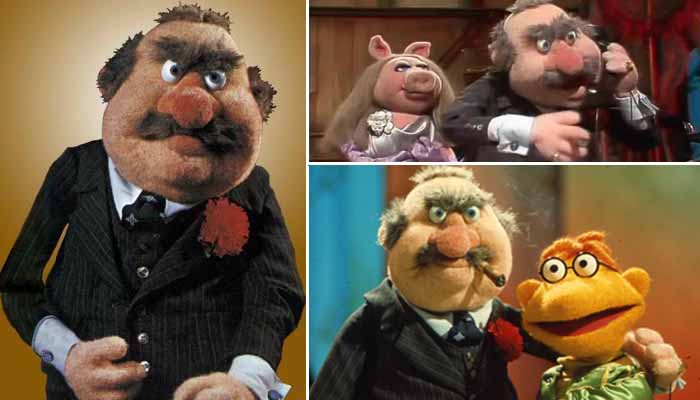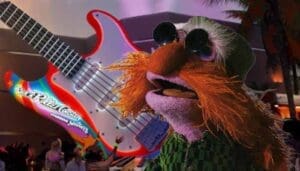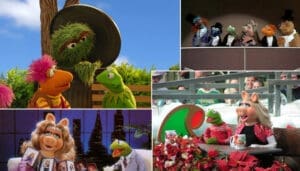Beyond Kermit and Piggy – Diving Deep into the Muppetverse
When you think Muppets, who comes to mind? Kermit the Frog, nervously trying to keep the show running? Miss Piggy, delivering a powerhouse performance (or a karate chop)? Maybe Fozzie Bear, dodging tomatoes from Statler and Waldorf? These icons are beloved worldwide, the undeniable stars of a felt-and-fur universe that’s charmed audiences for decades. But the true magic of the Muppets lies deeper than just the headliners. It’s woven into the rich tapestry of supporting characters, the background players, the weirdos, and the walk-ons who populate their chaotic world. From Lew Zealand and his boomerang fish to Crazy Harry and his love for explosions, this extended cast gives the Muppet universe its unique texture and depth.
Among these fascinating, lesser-known figures lurks a name whispered backstage with a mixture of fear and exasperation: J.P. Grosse. He was the owner of the venerable Muppet Theater, the grand old vaudeville house that served as the setting for The Muppet Show. Though rarely seen, his influence was constantly felt, a looming presence whose demands could throw the entire production into chaos. He’s a figure of mild backstage terror and enduring mystery, Scooter’s uncle, and a character whose story offers a unique glimpse into the workings (and worries) of the Muppet world. Let’s pull back the curtain on this obscure but significant Muppet figure.
Who Is J.P. Grosse?: The Man Behind the Threats
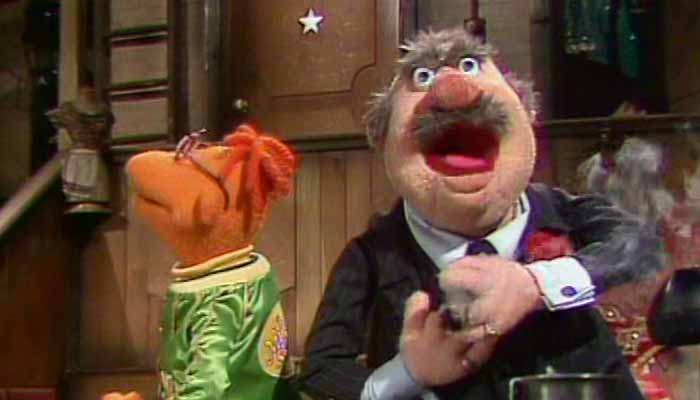
So, who exactly was J.P. Grosse? First and foremost, he was the owner of The Muppet Theatre, the stage upon which Muppet mayhem unfolded weekly. While Kermit was the director and master of ceremonies, Grosse held the purse strings and the deed. According to George the Janitor, Grosse wasn’t the first owner, and the theater had apparently seen better days before he took over, hinting that his stewardship wasn’t exactly focused on upkeep.
Visually, J.P. Grosse was a humanoid Muppet, realized as a hand-rod puppet skillfully performed by the legendary Jerry Nelson. One of the original puppets, dating from around 1977, was even donated to the Smithsonian’s National Museum of American History in 2013, a testament to his place, however small, in Muppet history.
But Grosse wasn’t known for his charming personality or stage presence. His primary characteristic, especially during the early seasons of The Muppet Show, was his ability to instill fear in Kermit the Frog. He rarely delivered his demands in person; instead, they were often casually relayed by his nephew, Scooter, the theater’s gofer. These “requests” were enough to make Kermit immediately cave, highlighting Grosse’s power over the perpetually stressed frog. Beyond the theater, Grosse apparently diversified his portfolio, as he was also mentioned as owning the J. P. Grosse Collection Agency in one episode. He represented the often unseen, but very real, pressures of finance and ownership that constantly loomed over the Muppets’ creative chaos, a personification of the business side of show business.
The Nepotism Factor: Enter Scooter, the Gofer with Connections
The arrival of Scooter in Episode 106 (guest-starring Jim Nabors) perfectly illustrates J.P. Grosse’s influence. Scooter, a fresh-faced, eager humanoid Muppet (usually clad in his signature green jacket with eyes embedded in his glasses), applied for a job as a “gofer”. After clarifying that he meant he would “go-fer” coffee and sandwiches, not that he resembled a gopher, Kermit initially balked at hiring him due to lack of funds.
That hesitation vanished the moment Scooter mentioned his uncle owned the theater. Suddenly, Kermit was offering $20 a week. Scooter, perhaps innocently, perhaps cannily, suggested his uncle might be disappointed and promptly haggled his way up to $30. This scene established Scooter’s entry into the Muppet troupe as a clear case of nepotism. His job security wasn’t based on merit alone, but on his family connection to the man in charge.
Throughout the first season, Scooter frequently leveraged this connection. Whether he wanted to squeeze in a last-minute act (like the Danceros he “discovered”) or needed Kermit’s approval for something questionable, casually mentioning his uncle J.P. Grosse usually did the trick. Even George the Janitor quickly changed his tune from complaining about the theater’s terrible new owner to praising him once he learned Scooter was his nephew. This dynamic defined Scooter’s initial role; he wasn’t malicious, perhaps not even fully aware of the implied threat, but his connection to Grosse was his primary narrative function. Interestingly, as The Muppet Show progressed and J.P. Grosse faded from prominence (both in mentions and appearances), Scooter’s character evolved. The nepotism angle was gradually dropped, and he became a genuinely efficient, helpful, and loyal assistant to Kermit, often acting more like a stage manager and friend. This shift suggests that Scooter’s initial reliance on his uncle’s influence was directly tied to Grosse’s narrative function as the powerful, intimidating owner; as Grosse’s role diminished, Scooter could develop into a more independent character.
An Off-Stage Menace: Grosse’s Reign of Mentioned Terror
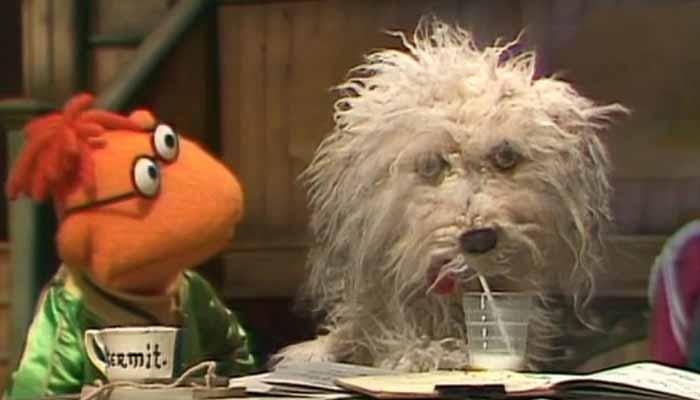
Before J.P. Grosse ever stepped onto the Muppet Theater stage himself, his presence loomed large. During the first season of The Muppet Show, he was a frequently mentioned, unseen force, his name alone enough to send shivers down Kermit’s spine. The writers cleverly built his intimidating persona through hearsay and the consequences of his off-stage actions, creating conflict and humor without needing to show the man himself.
The examples are numerous and often absurd:
- In Episode 101 (Juliet Prowse), Grosse’s pet Muppy apparently demanded its own act, dressing room, and even its own show, requests relayed via Scooter.
- In Episode 104 (Ruth Buzzi), Grosse took a more direct approach to meddling, sending a bizarre mechanical wind-up replica of Kermit to potentially replace the original host.
- Episode 106 (Jim Nabors) saw Scooter secure his job through the Grosse connection, as detailed earlier.
- In Episode 202 (Zero Mostel), Grosse dangled the much-needed payroll money in front of Kermit, but only on the condition that Kermit add lady wrestling to the show’s lineup. This was the first time he was mentioned by name.
- His influence extended to guest stars too. In Episode 214 (Elton John), Grosse apparently insisted that Elton perform “Bennie and the Jets”.
- Perhaps most disruptively, in Episode 410 (Kenny Rogers), Grosse sold the mineral rights underneath the guest star’s dressing room to a group of Muppet Arabs, who promptly began drilling for oil, causing chaos throughout the theater.
These instances effectively established J.P. Grosse as a powerful, capricious, and intimidating figure whose whims could dictate everything from programming choices to payroll, all without him needing to set foot in the building. This strategy of using an unseen antagonist built anticipation for his eventual appearance while providing a steady stream of external pressure for Kermit to react against.
Stepping Into the Light: Grosse’s Rare On-Screen Moments
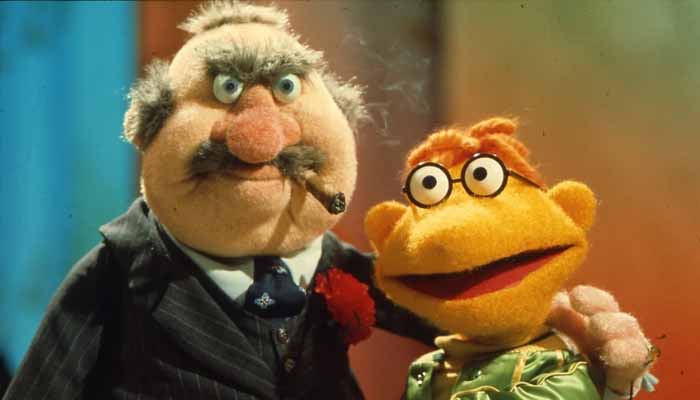
After a season and a half of being an off-stage boogeyman, J.P. Grosse finally made his on-screen debut. His appearances were few – only three documented times on The Muppet Show – but memorable, often confirming the difficult personality hinted at by the earlier mentions.
- Episode 205: Judy Collins (First Appearance): Grosse arrived at the theater with bad news: he intended to tear the place down and convert it into a junkyard. His rationale, delivered with Jerry Nelson’s typically brilliant performance capturing Grosse’s ruthless nature, was blunt: “There’s more money in real junk than the junk you’ve got here”. This threat formed the main conflict of the episode’s backstage plot. The resolution, however, was pure Muppet logic: Grosse ultimately decided against demolition because the theater was already in such disrepair, it would be a waste of money to tear it down. This episode also featured a classic Miss Piggy moment where she hilariously (and unsuccessfully) tried to flirt with the unimpressed Grosse, and a slapstick bit where Waldorf, declaring the theater “solid as a rock,” stomped his foot and promptly fell through the balcony floor.
- Episode 218: Jaye P. Morgan: Grosse’s second appearance played on the homophonic similarity between his name and that of the guest star, Jaye P. Morgan. This led to predictable Muppet confusion. Jaye P. overheard Kermit complaining about how awful it was to have “J.P.” around, naturally assuming he meant her. Later, Grosse misunderstood Kermit expressing a desire for “Jaye P.” to sing the closing number, leading Grosse to believe he was being offered a spot on stage – an opportunity he seemed willing to consider, “if the price is right”.
- Episode 221: Bob Hope (UK Spot “Long, Long Ago”): Grosse’s final appearance on The Muppet Show occurred during the UK-exclusive musical number, a medley of old songs titled “Long, Long Ago”. In a cozy scene featuring a large cast of Muppets gathered by a fireplace, Grosse’s presence was noted as distinctly “off-putting” by Muppet fan site ToughPigs. While the other Muppets huddled together singing, Grosse sat alone in his chair, scowling, physically separate from the group. This visual isolation reinforced his status as an outsider, someone not quite part of the Muppet camaraderie, perhaps even suggesting, as the reviewer speculated, that he might be forcing the others to sing.
These few appearances solidified Grosse as a character defined by conflict, awkwardness, or isolation, perhaps hinting at why he wasn’t used more often.
To clarify his presence (or lack thereof), here’s a summary of J.P. Grosse’s notable involvements during The Muppet Show:
| Episode | Guest Star | J.P. Grosse’s Role/Mention Context | Type | Source Snippets |
|---|---|---|---|---|
| 101 | Juliet Prowse | Relaying demands for his pet Muppy via Scooter | Mentioned | |
| 104 | Ruth Buzzi | Sends mechanical wind-up TV show host to replace Kermit | Mentioned | |
| 106 | Jim Nabors | Scooter hired due to uncle’s ownership; negotiates pay | Mentioned | |
| 202 | Zero Mostel | Offers payroll money if Kermit schedules lady wrestling | Mentioned | |
| 205 | Judy Collins | Appears; threatens theater demolition for junkyard | Appearance | |
| 214 | Elton John | Wants Elton John to perform “Bennie and the Jets” | Mentioned | |
| 218 | Jaye P. Morgan | Appears; confusion due to homophonic name with guest star | Appearance | |
| 221 | Bob Hope | Appears in “Long, Long Ago” UK Spot medley; sits apart | Appearance | |
| 410 | Kenny Rogers | Sold mineral rights under guest star’s dressing room | Mentioned |
This table clearly shows the pattern: Grosse was a background influence far more often than an active participant, with his direct appearances clustered in the second season.
The Character Conundrum: Why Was J.P. Grosse So Scarce?
Given his unique position as the theater owner and Scooter’s uncle, why didn’t J.P. Grosse become a more recurring character? The answer seems to lie in a fundamental clash between the character’s nature and the overall spirit of the Muppets.
Legendary Muppet writer Jerry Juhl, in the book Of Muppets and Men, provided perhaps the most direct explanation: “J. P. Grosse was a good concept so long as we didn’t see him, but when we introduced him in person, he was just too harsh. You didn’t want to have him around”. This sentiment is echoed in a Muppet Mindset article, which notes that the writers found it difficult to write for Grosse once he became a physical presence on set.
The idea of J.P. Grosse – the unseen, demanding owner whose whims created comedic obstacles for Kermit – worked beautifully. It tapped into the relatable anxieties of dealing with unreasonable bosses or bureaucratic hurdles. However, bringing that character into the vibrant, chaotic, and ultimately good-natured world of the Muppet Theater proved challenging. His inherent “harshness” and focus on business (“more money in real junk”) represented the colder realities that the show generally sought to escape or lampoon, not embody directly. As one ToughPigs reviewer noted regarding Grosse’s debut, treating the Muppet Theater as a “real place with real concerns” didn’t always mesh perfectly with the show’s usual tone. Grosse personified those concerns, and perhaps too effectively for comfort. His scarcity, therefore, appears to be less an oversight and more a deliberate creative choice, preserving the show’s balance by keeping the overtly cynical aspects of show business mostly off-stage.
Grosse Sightings: Life Beyond The Muppet Show
Despite his limited speaking roles on The Muppet Show and the creative challenges he presented, the J.P. Grosse puppet didn’t disappear entirely. He continued to pop up in various Muppet productions over the years, although almost exclusively in background or cameo roles, often nameless and voiceless. This suggests a shift in his function – from a minor character driving plot points to a recognizable visual element, perhaps an Easter egg for dedicated fans or simply a way to fill out crowd scenes with a familiar (if obscure) face.
His film appearances include brief, non-speaking moments in the finales of The Muppet Movie (during “The Rainbow Connection”) and The Muppets Take Manhattan (at the wedding). He also appeared in the background of The Muppet Christmas Carol and Muppet Treasure Island. Ironically, as noted by Muppet Mindset, Grosse was frequently used in the background during the 1990s, a period when Scooter himself was largely absent from Muppet productions.
On television, Grosse made an appearance in the special The Muppets: A Celebration of 30 Years. He was also a frequent background presence on Muppets Tonight (1996-1998), often seen silently in the control room. During this period, the puppet was performed by various puppeteers, including Kevin Clash, Leslie Carrara-Rudolph, and Allan Trautman. His specific role there remained undefined.
Beyond the screen, Grosse has appeared in illustrations for various Muppet books like Bo Saves the Show and comic series such as The Muppet Show Comic Book and Muppet Sherlock Holmes. A Muppets comic strip from 1981 even added a tidbit about his wife owning a newspaper chain. He also existed in full-bodied form for the Muppet Show on Tour: 2nd Edition live show. These scattered appearances show that while his character’s narrative potential might have been limited, the puppet itself remained a part of the Muppet visual landscape.
What Ever Happened to J.P. Grosse?: Loose Ends and Legacy
Like many things in the Muppet universe, the ultimate fate of J.P. Grosse and the ownership of the Muppet Theater remain delightfully ambiguous. The continuity is flexible, often adapting to the needs of the specific story being told.
A significant piece of evidence comes from a deleted scene in the 2002 TV movie It’s a Very Merry Muppet Christmas Movie. In this scene, Kermit explicitly states that J.P. Grosse had died and left the theater to the Muppets in his will. While this scene was cut, a line remains in the final film where Scooter mentions that his uncle “used to own the theater,” implying Grosse was no longer the owner, for whatever reason.
However, Muppet writer Jim Lewis offered a playful, tongue-in-cheek rebuttal to the idea of Grosse’s demise, stating: “Dead? J.P. Grosse? I think not. Highly exaggerated and all that. Why, compared to Statler and Waldorf, he’s a mere child”. This meta-commentary embraces the character’s obscurity and the Muppets’ loose approach to canon.
Further complicating matters are the different scenarios presented in later productions. It’s a Very Merry Muppet Christmas Movie features Joan Cusack as a banker holding the mortgage on the theater (which is inexplicably located in New York for that film). The 2011 film The Muppets centers on saving the theater (now back in Los Angeles, next to Muppet Studios) from oil magnate Tex Richman, who has somehow acquired the right to buy it unless the Muppets can raise enough money. Whether Grosse sold it, lost it, or indeed passed away is never definitively settled. This fluidity suggests that Grosse’s ultimate fate is less important than using the theater’s ownership as a plot device when needed. The ambiguity itself becomes part of his legacy.
The Ghost in the Machine (or the Balcony)
J.P. Grosse occupies a unique space in the Muppet pantheon. He is a character whose idea – the grumpy, unseen owner, the embodiment of external pressures, the reason for Scooter’s initial job – proved more enduring and perhaps more effective than his actual on-screen presence. His few appearances were marked by conflict or awkwardness, reinforcing the notion that his particular brand of harsh reality didn’t quite gel with the Muppets’ optimistic chaos.
His legacy is one of influential obscurity. He was the necessary catalyst for Scooter’s introduction and early character arc. He provided countless moments of comedic stress for Kermit through his off-screen demands. And he serves as a fascinating case study in Muppet character development, demonstrating how some concepts work better in theory or at a distance.
While he’ll never share the spotlight with Kermit or Piggy, J.P. Grosse remains a delightful piece of Muppet trivia, a testament to the detailed world-building that Jim Henson and his collaborators achieved. He reminds us that even the rarely seen figures, the ghosts in the machine (or perhaps just scowling from the balcony), contribute to the rich, complex, and enduring magic of the Muppets. His story is a small thread, but one that adds texture to the magnificent Muppet tapestry.

